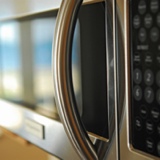Information
-
Document No.
-
Site;
- Padua College
- Frensham
- Gib Gate
- Sturt
- Banyo
- Dining Room
-
Conducted on;
-
Inspection Conducted By;
- Chris
- Bill
- Michael
- Troy
- Garry
- Tyson
- Steve
- Courtney
- Lance
-
Brand;
-
Model;
-
Serial Number;
General Information
-
All microwave ovens have at least two safety interlock switches which stop the generation of microwaves immediately the door is opened. The design of modem microwave ovens is such that the microwaves should be contained within the oven, but it is still possible for some leakage to occur around the doors of certain microwave ovens. Generally, the required design of oven doors should restrict this leakage to a level well below that recommended by the Australian/NewZealand Standard AS/NZ560335.2.25:2002 Household and similar electrical appliances - Safety Part 2.25: Particular requirements Microwave ovens. The Standard specifies a test to assess the level of microwave leakage and states that 'The microwave leakage at any point 50 millimetres or more from the external surface of the appliance shall not exceed 50 watts per square metre.' This Standard applies to ovens designed for domestic applications, even if used in a workplace. The recommended limit is conservative and includes significant safety factors, so that even leakage levels appreciably above the limit will have no known effect on human health. All microwave ovens have at least two safety interlock switches which stop the generation of microwaves immediately the door is opened. The design of modem microwave ovens is such that the microwaves should be contained within the oven, but it is still possible for some leakage to occur around the doors of certain microwave ovens. Generally, the required design of oven doors should restrict this leakage to a level well below that recommended by the Australian/NewZealand Standard AS/NZ560335.2.25:2002 Household and similar electrical appliances - Safety Part 2.25: Particular requirements Microwave ovens. The Standard specifies a test to assess the level of microwave leakage and states that 'The microwave leakage at any point 50 millimetres or more from the external surface of the appliance shall not exceed 50 watts per square metre.' This Standard applies to ovens designed for domestic applications, even if used in a workplace. The recommended limit is conservative and includes significant safety factors, so that even leakage levels appreciably above the limit will have no known effect on human health.
-
Precautions for Radiation safety in the use of Microwave Ovens · Follow the oven manufacturer's instructions on recommended operating procedures and safety precautions. · Never tamper with or inactivate the interlocking devices. · Never use the oven without the trays provided by the manufacturer unless specifically allowed in the manufacturer's instructions. · Never operate the oven without a load (ie. an absorbing material such as food or water) in the oven cavity unless specifically allowed in the manufacturer's instructions. · Never rest heavy objects such as food containers on the door while it is open. · Clean the oven cavity, the door and seals with water and a mild detergent at regular intervals (do not use abrasive cleaning pads). · Supervise children using microwave ovens.
-
A microwave oven should only be used if an inspection confirms all of the following points: · The surface of the door is not damaged. · The door fits squarely and securely and opens and closes smoothly. · The door hinges are in good condition. · The oven is clean and in particular the door edges and interior surrounds are not covered with food or burnt material. · No corrosion is evident on the door, the door hinges or the oven interior.
-
How do Microwave Ovens Work? In the microwave oven, an electronic device called a magnetron is used to produce the microwaves. These microwaves have a frequency of 2,450 MHz1 enclosed metal oven cavity where they are reflected around the oven walls and absorbed in food or drink placed in the oven. Uneven absorption may cause localised ‘hot spots’. The microwaves penetrate the food or liquid and agitate the water molecules within. This causes molecular friction, which produces heat and results in a rapid rise in temperature. Cooking time is usually much shorter than in a conventional oven. The rate of heating depends on the moisture content, shape, volume and mass of food present. Uneven heating can occur in some foods where the outside may be only warm while the inside may be close to boiling (jam filled donuts or meat pies are examples). In other foods, some parts will be cooked, while others are not. Some parts of frozen food may remain frozen if insufficient time is allowed for the heating process. 1 MHz is an abbreviation for Megahertz; 1 MHz is one million cycles of electromagnetic wave oscillations per second.
-
What are the health issues of Microwave Exposure? Exposure to sufficiently high levels of microwaves will cause heating. In the case of human tissue, excessive heating could have serious health effects such as deep tissue burns and hyperthermia. The purpose of Australian Standards is to avoid all known adverse health effects by limiting exposures to levels below those at which heating occurs. Extensive research has provided no substantiated evidence that microwave exposure, at any level, either causes or promotes cancer.
-
How Safe are Microwave ovens? Microwaves generated in microwave ovens cease to exist once the electrical power to the magnetron is turned off (like visible light from light globes). They do not remain in the food when the power is turned off. Neither can they make the food or the oven radioactive. Therefore, food cooked in a microwave oven is not a radiation hazard. All microwave ovens have at least two safety interlock switches which stop the generation of microwaves immediately the door is opened. The design of modern microwave ovens is such that the microwaves should be contained within the oven, but it is still possible for some leakage to occur around the doors of certain microwave ovens. Generally, the required design of oven doors should restrict this leakage to a level well below that recommended by the Australian/New Zealand Standard AS/NZS60335.2.25:2002 Household and similar electrical appliances – Safety Part 2.25: Particular requirements - Microwave ovens. The Standard specifies a test to assess the level of microwave leakage and states that 'The microwave leakage at any point 50 millimetres or more from the external surface of the appliance shall not exceed 50 watts per square metre'. This Standard applies to ovens designed for domestic applications, even if used in a workplace. The recommended limit is conservative and includes significant safety factors, so that even leakage levels appreciably above the limit will have no known effect on human health. Surveys by organisations providing testing services have shown that microwave oven leakage levels in excess of the recommended limits are rare and an oven in good condition and used correctly is safe. If an oven appears damaged, it should not be used until a suitably experienced technician has tested the oven and checked that the leakage does not exceed the recommended limit. Routine testing of microwave oven leakage is not considered necessary.
-
•While there is no requirement for recurrent testing for microwave leakage, regular visual inspections are recommended to check for the following: •the sealing surfaces are clean and do not show any sign of damage; •the door closes cleanly and there is no distortion of the frame; •the window panel is not damaged. •If there is any evidence of this type of damage the unit should be taken out of service and referred to the authorised service agent. •Do not attempt unauthorised repairs or modifications to the mechanical or electrical systems of a microwave oven. Where a unit is suspected to be faulty it should be disconnected from the power supply, removed from service and labelled with an appropriate tag while awaiting repair or disposal. •Any irreparable or redundant microwave oven should be rendered inoperable by an electrical tradesperson – including removal of the plug and cord – before disposal. •While there is no requirement for recurrent testing for microwave leakage, regular visual inspections are recommended to check for the following: •the sealing surfaces are clean and do not show any sign of damage; •the door closes cleanly and there is no distortion of the frame; •the window panel is not damaged. •If there is any evidence of this type of damage the unit should be taken out of service and referred to the authorised service agent. •Do not attempt unauthorised repairs or modifications to the mechanical or electrical systems of a microwave oven. Where a unit is suspected to be faulty it should be disconnected from the power supply, removed from service and labelled with an appropriate tag while awaiting repair or disposal. •Any irreparable or redundant microwave oven should be rendered inoperable by an electrical tradesperson – including removal of the plug and cord – before disposal. •While there is no requirement for recurrent testing for microwave leakage, regular visual inspections are recommended to check for the following: •the sealing surfaces are clean and do not show any sign of damage; •the door closes cleanly and there is no distortion of the frame; •the window panel is not damaged. •If there is any evidence of this type of damage the unit should be taken out of service and referred to the authorised service agent. •Do not attempt unauthorised repairs or modifications to the mechanical or electrical systems of a microwave oven. Where a unit is suspected to be faulty it should be disconnected from the power supply, removed from service and labelled with an appropriate tag while awaiting repair or disposal. •Any irreparable or redundant microwave oven should be rendered inoperable by an electrical tradesperson – including removal of the plug and cord – before disposal.
Items to check
-
The surface of the door is not damaged
-
The door fits squarely and securely, opens and closes smoothly
-
The door hinges are in good condition
-
The oven is clean and in particular the door edges and interior surrounds are not covered in food or burnt material
-
No corrosion is evident on the door, the hinges or the oven interior.
-
Microwave leakage testing device used?
-
Was any leakage detected?
-
In the opinion of the inspector, is the Microwave Oven safe to use?













